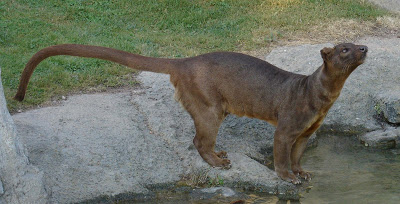
Habitat
The fossa can be seen living a
solitary life in the dry and humid forests of Madagascar (ARKive
2013), and the population of fossa on the island is estimated to
be fewer
 than 2,500 individuals (EDGE of Existence (n.d.)) The
species is found to be living on the ground in the forests or
high up in the trees during all seasons of the year. They can be
seen anywhere from the coastal lowlands to high mountainous
areas, which reach almost 2,000 meters in elevation. The fossa
is usually not found outside of a forest habitat, with the
exception of relocation to another arboreal area on the island.
It is equally active during the day and night, with the omission
of the more extreme temperatures of the year and breeding
season, where they are seen as inactive (Encyclopedia of Life
2013).
than 2,500 individuals (EDGE of Existence (n.d.)) The
species is found to be living on the ground in the forests or
high up in the trees during all seasons of the year. They can be
seen anywhere from the coastal lowlands to high mountainous
areas, which reach almost 2,000 meters in elevation. The fossa
is usually not found outside of a forest habitat, with the
exception of relocation to another arboreal area on the island.
It is equally active during the day and night, with the omission
of the more extreme temperatures of the year and breeding
season, where they are seen as inactive (Encyclopedia of Life
2013).
Both male and female fossas occupy multiple territories that are marked with secretions from their anal glands. These regions vary in size and depend on the abundance of prey in that area. On the island of Madagascar, there are many organisms that live alongside the Fossa, made up of many species of birds, reptiles, amphibians, insects, lemurs, and other small mammals. These animals of Madagascar include the fascinating aye aye, manatee, bottlenosed dolphin, and green sea turtle. Since the Fossa is the largest carnivore on the island, they prey on all of these organisms, but they are seen consuming lemurs the most, which make up 50% of their diets (ARKive 2013).
Fossas are known to live in areas with
low population density, until recently where they have been driven
more toward human activity. This is a result of habitat loss over
the last 50 years due to hunting, logging, and cutting and burning
down trees to create fields. In fact, only 8% of the original
forests of Madagascar are left (EDGE of Existence (n.d.)). All of
these factors explain why these creatures are being compelled toward
human settlements and eating their livestock, which leads to locals
killing them to protect their farms (EDGE of Existence (n.d.)). As a
result of this, the Fossa have been listed as “Vulnerable” in the
IUCN Red List of Threatened Species due to population reduction
surpassing 30% in the last 20 years (Hawkins & Dollar 2008). Click
here to view
where fossas lie on the classification chart of Threatened Species.
(n.d.)). All of
these factors explain why these creatures are being compelled toward
human settlements and eating their livestock, which leads to locals
killing them to protect their farms (EDGE of Existence (n.d.)). As a
result of this, the Fossa have been listed as “Vulnerable” in the
IUCN Red List of Threatened Species due to population reduction
surpassing 30% in the last 20 years (Hawkins & Dollar 2008). Click
here to view
where fossas lie on the classification chart of Threatened Species.
Photo 1: Nick Garbutt
Photo2: Ran Kirlian 2008